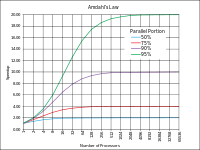- Distributed shared memory
-
Distributed Shared Memory (DSM), in Computer Architecture is a form of memory architecture where the (physically separate) memories can be addressed as one (logically shared) address space. Here, the term shared does not mean that there is a single centralized memory but shared essentially means that the address space is shared (same physical address on two processors refers to the same location in memory)[1]. Alternatively in computer science it is known as (DGAS), a concept that refers to a wide class of software and hardware implementations, in which each node of a cluster has access to shared memory in addition to each node's non-shared private memory.
Software DSM systems can be implemented in an operating system, or as a programming library. Software DSM systems implemented in the operating system can be thought of as extensions of the underlying virtual memory architecture. Such systems are transparent to the developer; which means that the underlying distributed memory is completely hidden from the users. In contrast, Software DSM systems implemented at the library or language level are not transparent and developers usually have to program differently. However, these systems offer a more portable approach to DSM system implementation.
Software DSM systems also have the flexibility to organize the shared memory region in different ways. The page based approach organizes shared memory into pages of fixed size. In contrast, the object based approach organizes the shared memory region as an abstract space for storing shareable objects of variable sizes. Another commonly seen implementation uses a tuple space, in which the unit of sharing is a tuple.
Shared memory architecture may involve separating memory into shared parts distributed amongst nodes and main memory; or distributing all memory between nodes. A coherence protocol, chosen in accordance with a consistency model, maintains memory coherence.
Examples of such systems include:
- Kerrighed
- OpenSSI
- MOSIX
- TreadMarks
- DIPC
See also
References
- ^ Patterson, David A. and John L. Hennessy (2007). Computer architecture : a quantitative approach, Fourth Edition, Morgan Kaufmann Publishers, p. 201. ISBN 0123704901.
External links
- Distributed Shared Cache
- Memory coherence in shared virtual memory systems by Kai Li, Paul Hudak published in ACM Transactions on Computer Systems, Volume 7 Issue 4, Nov. 1989
Parallel computing General 
Levels Threads Theory Elements Coordination Multiprocessing · Multithreading (computer architecture) · Memory coherency · Cache coherency · Cache invalidation · Barrier · Synchronization · Application checkpointingProgramming Hardware Multiprocessor (Symmetric · Asymmetric) · Memory (NUMA · COMA · distributed · shared · distributed shared) · SMT
MPP · Superscalar · Vector processor · Supercomputer · BeowulfAPIs Ateji PX · POSIX Threads · OpenMP · OpenHMPP · PVM · MPI · UPC · Intel Threading Building Blocks · Boost.Thread · Global Arrays · Charm++ · Cilk · Co-array Fortran · OpenCL · CUDA · Dryad · DryadLINQProblems Embarrassingly parallel · Grand Challenge · Software lockout · Scalability · Race conditions · Deadlock · Livelock · Deterministic algorithm · Parallel slowdown
Categories:- Distributed computing architecture
Wikimedia Foundation. 2010.
